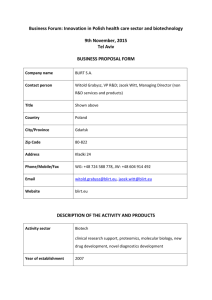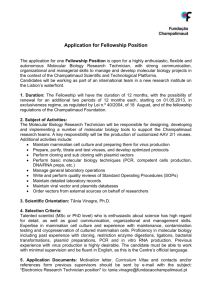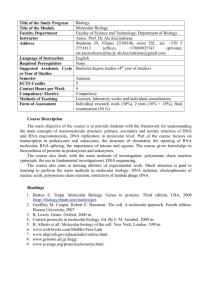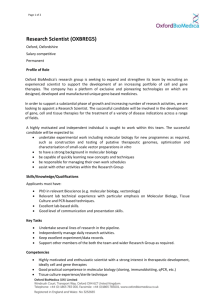Former PhD students: Chiara Aringhieri, Silvia Vivarelli
advertisement
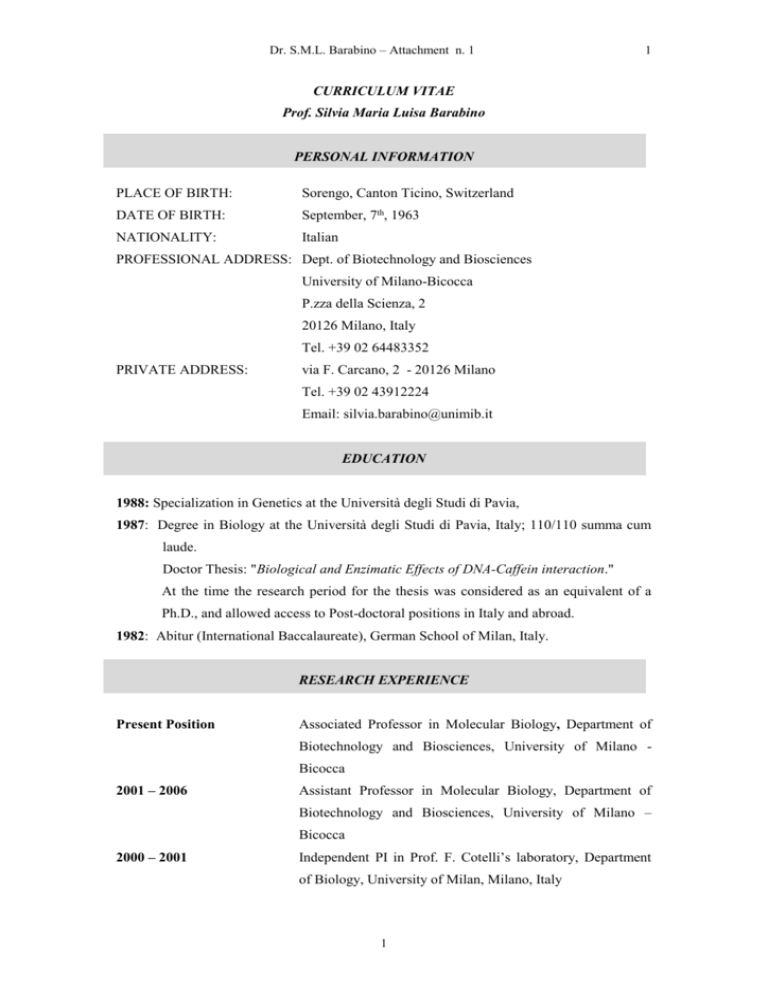
Dr. S.M.L. Barabino – Attachment n. 1 1 CURRICULUM VITAE Prof. Silvia Maria Luisa Barabino PERSONAL INFORMATION PLACE OF BIRTH: Sorengo, Canton Ticino, Switzerland DATE OF BIRTH: September, 7th, 1963 NATIONALITY: Italian PROFESSIONAL ADDRESS: Dept. of Biotechnology and Biosciences University of Milano-Bicocca P.zza della Scienza, 2 20126 Milano, Italy Tel. +39 02 64483352 PRIVATE ADDRESS: via F. Carcano, 2 - 20126 Milano Tel. +39 02 43912224 Email: silvia.barabino@unimib.it EDUCATION 1988: Specialization in Genetics at the Università degli Studi di Pavia, 1987: Degree in Biology at the Università degli Studi di Pavia, Italy; 110/110 summa cum laude. Doctor Thesis: "Biological and Enzimatic Effects of DNA-Caffein interaction." At the time the research period for the thesis was considered as an equivalent of a Ph.D., and allowed access to Post-doctoral positions in Italy and abroad. 1982: Abitur (International Baccalaureate), German School of Milan, Italy. RESEARCH EXPERIENCE Present Position Associated Professor in Molecular Biology, Department of Biotechnology and Biosciences, University of Milano Bicocca 2001 – 2006 Assistant Professor in Molecular Biology, Department of Biotechnology and Biosciences, University of Milano – Bicocca 2000 – 2001 Independent PI in Prof. F. Cotelli’s laboratory, Department of Biology, University of Milan, Milano, Italy 1 Dr. S.M.L. Barabino – Attachment n. 1 1994 – 2000: 2 Assistant in Prof. W. Keller's laboratory, Cell Biology Department, Biozentrum, University Basel, Switzerland. 1992 - 1994: Post-doctoral Fellow in Dr. E. Boncinelli's laboratory, DIBIT, H S. Raffaele, Milan, Italy. 1988 - 1992: Post-doctoral Fellow in Dr. A.I Lamond's laboratory, European Molecular Biology Laboratory, Heidelberg, Germany. July - October 1988: Training in Prof. P.J. Hagerman’s laboratory, Department of Biochemistry, Biophysics and Genetics, University of Colorado, Health Sciences Center, Denver, Colorado, U.S.A. 1985 – 1987 Experimental thesis for the Laurea (Degree) in Biology, in the lab of Dr. MA Pedrini, Institute of Molecular Genetics, National Research Council, CNR, Pavia AREAS OF RESEARCH INTEREST Current research interest: “Mechanisms of post-transcriptional regulation of mammalian gene expression and their role in human disease” Genetic regulation of gene expression involves a complex network of interactions not only at the level of transcription but also at the levels of mRNA processing, export and quality control. In higher metazoans, most protein-coding genes are transcribed as primary transcripts (pre-mRNAs) that are composed of several coding exons, separated by intervening regions (introns). The maturation of pre-mRNAs (pre-mRNA splicing and 3’ end polyadenylation) constitutes a critical step for the regulation of gene expression. During RNA splicing cells may remove and splice together different segments of RNA from the same gene, resulting in alternatively spliced gene products. In many cases, the alternative spliced products can have very different biological effects. Defects in the splicing process play a central role in many human diseases. Alternative splicing is particularly common in genes expressed in the mammalian nervous system. Our work concentrates on a range of projects related to the control of pre-mRNA splicing under physiological and pathological conditions in neuronal cells. Starting from a whole-genome, splicing sensitive microarray analysis of two different cellular models of neurodegeneration we have identified a common set of genes that are deregulated either at the transcription or at the splicing level. Bioinformatic analysis revealed that several of these genes are involved in neuritogenesis. Based on these results, we aim at determining the 2 Dr. S.M.L. Barabino – Attachment n. 1 3 mechanisms that couple the choice of alternative exons to transcription. In this study we concentrate on Brahma, a component of the SWI/SNF chromatin-remodelling complex, which is significantly downregulated in our models. By modulating the levels of Brahma we study how chromatin remodelling affects transcription and splicing of genes involved in neurite outgrowth. A second project concerns the mechanisms of action of splicing regulators and to understand their roles in neuronal development. This project is focused on SRPK2, a protein kinase specific for the SR (serine/arginine-rich domain) family of splicing factors. A final area of interest is focused on the effect of cell stress on the maturation of transcripts regulating cell cycle and cell death. We are currently studying the mechanisms by which DNA damage caused by oxidative stress affects alternative splicing. To address all these questions, we are using a combination of in vitro culture assay systems, biochemistry, microscopy, and transgenic mouse models. Finally we have just initiated a project concerning the characterization of role of micro RNAs in neurodegenration. 2000 – 2008 To understand how the correct splice sites are selected, we studied the definition of 3'-terminal exons. Our working hypothesis was that a subset of spliceosomal SR proteins participates together with the 3'-end processing factor CF Im in the coordination of splicing and polyadenylation. We have characterized the 3’ end processing factor CF Im and we have shown that it shuttles continuously between the nucleus and the cytoplasm in association to mRNA. We have tested with different in vitro and in vivo approaches if CF Im plays a direct role in mRNA transport. In collaboration with Prof. Daniel Schuemperli we have also characterized the role of CF Im in the maturation of histone mRNAs. Finally, we have initiated the study of the effect of oxidative stress on the intracellular distribution and on the phosphorylation status of splicing factors. 1994 – 2000 in Prof. W. Keller's laboratory at the Department of Cell Biology, Biozentrum, University Basel: biochemical and molecular characterization of the factors required for 3'-end processing of pre-mRNAs both in yeast and in mammalian cells; purification, cloning, and characterization the 30 kD subunit of CPSF, an essential component of the mammalian 3'-end processing machinery; cloning and characterization of its yeast homolog, Yth1p. 1992 - 1994 in Prof. Boncinelli’s laboratory at the D.I.BI.T, H S. Raffaele, Milan: cloning and expression analysis of homeobox genes in Zebrafish; isolation and characterization of the Zebrafish homolog of the human gene Emx1 during Zebrafish 3 Dr. S.M.L. Barabino – Attachment n. 1 4 development; isolation and characterization of a novel gene specifically expressed in the developing retina. 1987-1992 in the laboratory of Dr. A.I. Lamond at the E.M.B.L., Heidelberg: biochemical study of the molecular mechanism of pre-mRNA splicing in mammalian cells with focus on the role of U1 and U2 snRNPs in spliceosome assembly and in the splicing reaction. I contributed to setting up a novel approach for the purification of RNA:protein complexes from cell nuclear extracts using modified antisense oligonucleotides. SEMINARS PRESENTED AND INVITED LECTURES AT INTERNATIONAL MEETINGS 1st Post-EURASNET Symposium “Regulation of Gene Expression through RNA Splicing”, Trieste, March 24-27, 2012 Workshop “Frontiers in Epigenomics” Baeza, Spain, October 17-19, 2011 2010 SIBBM Seminar Frontiers in Molecular Biology, 6th meeting of the Italian Society for Biochemistry and Molecular Biology, 3 – 5 Iune 2010, Padua, Italy ALS/MND, European young investigator meeting, 22-24 May 2009, Turin,, Italy Swiss RNA Workshop, January 30, 2009, Bern, Switzerland RNA 2008 Annual Meeting of the RNA Society, July 28 - August 3rd, 2008, Berlin, Germany 9th Meeting of the Italian life Science Federation, September 26-29, 2007, Riva del Garda TN, Italy EMBO Workshop on “Mechanisms of nuclear transport”, Taormina, November 1st – 5th 2003 Cold Spring Harbor Meeting on "Eukaryotic mRNA processing", 25 – 29 August 1999, Cold Spring Harbor, N.Y., U.S.A. RNA'97, Second Annual Meeting of The RNA Society, 27 May - 1 June 1997, Banff, Canada SERVICE ACTIVITIES Grant reviewer for National Science Foundation Austrian Science Foundation Inserm European Young Investigator Award Scheme (EURYI) 4 Dr. S.M.L. Barabino – Attachment n. 1 5 Reviewer for professional journals PLoS Biology Journal Leukocyte Biology RNA Cell Research Experimental Cell Research Molecular and General Genetics ACADEMIC SERVICE Ph.D. Student Recruitment Committee PhD program in Molecular and Translation Medicine, DIMET, University of Milano-Bicocca (2005-present) International Graduate School in Molecular Medicine – Neuroscience, Vita-Salute University San Raffaele, Milano (2002-2005) STUDENTS AND THESES Short-term training of students : Simona Paro, Antonella Orlando, Valentina Romeo, Mirko Cavalleri Undergraduate students currently doing their thesis work in the lab: Andrea Maffioletti, Francesco Ranzini Former undergraduate students: Chiara Aringhieri, Stefano Cardinale, Paolo Bonetti, Davide Bonanno, Katia Mariniello, Simona Paro, Valentina Romeo Current PhD student: Gabriele Fontana Former PhD students: Chiara Aringhieri, Silvia Vivarelli TEACHING Associate Professor 2007 - present Molecular Biology, University of Milano – Bicocca, Milano, Italy Molecular Biology I – introductory course for 2nd year students Molecular Biology, II – advanced course for 3rd year students Integrated Advanced Biology Course – current topics in Molecular Biology for 4th year students 5 Dr. S.M.L. Barabino – Attachment n. 1 6 Advanced Molecular Biology Practical – practical course for 4th year students Assistant Professor 2001 - 2007 Molecular Biology, University of Milano – Bicocca, Milano, Italy Molecular Biology I – introductory course for 2nd year students Molecular Biology, II – advanced course for 3rd year students Advanced Biology – advanced course in Mol. Biology for 5th year students Molecular Biology Laboratory - practical course for 3rd year students Molecular Biology of the Eukaryotic Cell for 4th year students Teaching Assistant Biozentrum, University Basel, Basel, Switzerland 1996 - 2000 Grundkurs in Zellbiologie: Transcription and pre-mRNA Processing - theoretical and rd practical course for 3 year students st Übungen zu Grundlagen der Allgemeine Biologie - tutoring for 1 year students LIST of PUBLICATIONS (last five years) S. Vivarelli, S.C. Lenzken, M.-D. Ruepp, F. Ranzini, A. Maffioletti, R. Alvarez, O. Mühlemann, S.M.L. Barabino “Paraquat Modulates Alternative Pre-mRNA Splicing by Modifying the Intracellular Distribution of SRPK2.” PLoS One. 2013 Apr 16;8(4):e61980. doi: 10.1371/journal.pone.0061980. M.-D. Ruepp, D. Schümperli, , S. M.L. Barabino "mRNA 3' end processing and more multiple functions of mammalian cleavage factor I-68" Wiley Interdiscip Rev RNA. 2011 Jan-Feb;2(1):79-91. doi: 10.1002/wrna.35. S.C. Lenzken, V. Romeo, F. Zolezzi, F. Corsero, G. Lamorte, D. Bonanno, D. Biancolini, M.Cozzolino, A. Maracchioni, R. Sanges, T. Achsel, M.T. Carrì, R. A. Calogero, S.M.L. Barabino “Dysregulated expression and alternative splicing of genes controlling neuritogenesis and axon guidance revealed by exon-sensitive microarrays in models of neurodegeneration” Hum Mutat. 2011 Feb;32(2):168-82. doi: 10.1002/humu.21394. Epub 2011 Jan 25. M.-D. Ruepp, S. Vivarelli, R. S. Pillai, N. Kleinschmidt, T. N. Azzouz, S. M.L. Barabino, and D. Schümperli “Association of the 68 kDa subunit of mammalian cleavage factor I with the U7 snRNP: possible role in 3' end processing of animal histone mRNAs” Nucleic Acids Res. 2010 Nov;38(21):7637-50. Epub 2010 Jul 15. C. Aringhieri, M.-D. Ruepp, S. Vivarelli, S. Cardinale, S. Paro, D. Schümperli and S. M.L. Barabino “Mammalian 3’ end processing factor CF Im68 functions in mRNA export.” Mol. Biol. Cell, (2009), 20, 5211-5223. Raucci, A., Cugusi, S., Antonelli, A., Barabino, S.M., Monti, L., Bierhaus, A., Reiss, K., Saftig, P., Bianchi M.E., “A soluble form of the receptor for advanced glycation endproducts 6 Dr. S.M.L. Barabino – Attachment n. 1 7 (RAGE) is produced by proteolytic cleavage of the membrane-bound form by the sheddase a disintegrin and metalloprotease 10 (ADAM10).” FASEB J., (2008), 22, 3716-3727 Raucci, A, Cugusi, S, Antonelli, A, Barabino, S, Bierhaus, A, Saftig, P, Bianchi, ME A soluble form of RAGE is produced by proteolytic cleavage of the membrane bound form by the sheddase a disintegrin and metalloprotease 10 (ADAM10) JOURNAL OF LEUKOCYTE BIOLOGY(2008) 84 (2) B. Cisterna, F. Flach, L. Vecchio, S.M.L. Barabino, S. Battistelli, T.E. Martin, M. Malatesta, M. Biggiogera “Can a genetically-modified organism-containing diet influence embryo development? A preliminary study on pre-implantation mouse embryos.” Eur. J. Histochem. (2008), 52, 263-267. M. Malatesta, M. Biggiogera, B. Baldelli, S.M.L. Barabino., T.E. Martin, C. Zancanaro “Hibernation as a far-reaching program for the modulation of RNA transcription.” Microsc. Res. Tech. (2008), 71, p. 564-572. 7


